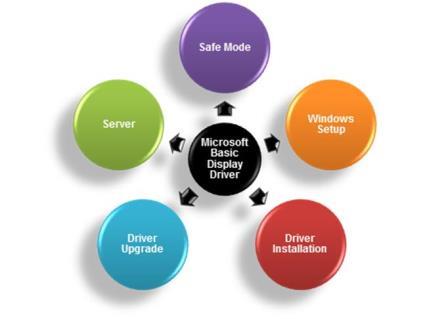Note
Access to this page requires authorization. You can try signing in or changing directories.
Access to this page requires authorization. You can try changing directories.
The Microsoft Basic Display Driver (BasicDisplay.sys) is a generic display driver that ships with the Windows operating system. It's the default display driver that the system loads in safe mode during setup when one of the following conditions occurs:
- An IHV graphics driver isn't present.
- The inbox installed graphics IHV driver isn't working or is disabled.
BasicDisplay's primary purpose is to enable Windows to write to the display controller's linear frame buffer.
The key benefits of using BasicDisplay are:
- BasicDisplay helps to enable a consistent end user and developer experience because it's compatible with DirectX APIs and technologies such as the Desktop Composition.
- Server scenarios can benefit from the higher functionality (specifically, features like reboot-less updates, dynamic start and stop, and so on) that are provided by the WDDM driver model.
- BasicDisplay supports Unified Extensible Firmware Interface (UEFI) Graphics Output Protocol (GOP).
- BasicDisplay works on both WDDM and legacy XDDM hardware.
BasicDisplay can use the video BIOS to manage modes and resolutions on a single monitor. On UEFI platforms, BasicDisplay inherits the linear frame buffer that is set during boot. In this case, no mode or resolution changes are possible. As shown in the following figure, BasicDisplay is used in the following scenarios:
Windows Server configurations that lack WDDM-capable graphics hardware can use BasicDisplay.
In the early phases of Windows setup, just before the final boot, only the BasicDisplay is loaded.
For example, a user has an older platform that is currently in working condition although it has no in-box graphics driver support for Windows 8 or later. The user upgrades to the current version of Windows and uses BasicDisplay for the setup, installation, and to retrieve an IHV driver if one is available.
During driver installation, in the following cases:
- When a user is installing a new WDDM IHV driver, BasicDisplay is used during the transition (from the point when the old WDDM IHV driver is uninstalled to the point before the new IHV driver is installed).
- When a user encounters problems installing the latest WDDM IHV driver, the user or system can disable the current graphics driver and fallback to using BasicDisplay.
- Driver upgrade: By using BasicDisplay, there's no need to go through a system reboot when upgrading to the IHV-recommended driver.
- Safe mode: In this mode, only trusted drivers get loaded, including BasicDisplay.

BasicDisplay is always used with BasicRender, which is the system-supplied module that exposes the functionality of WARP from an adapter in the kernel.
BasicRender can also be used on systems that don't have a render-capable driver installed (for example, display-only devices such as Matrox or DisplayLink that don't have a GPU).
Starting in Windows 11, both BasicDisplay and BasicRender run from their DriverStore locations in c:\Windows\System32\DriverStore.